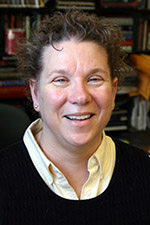
Gayle E. Woloschak, PhD, professor in Radiation Oncology and Radiology, created nanoparticles to target and destroy cancer cells, but when she wanted to see where they traveled to within cells, traditional x-ray imaging did not work.
“My main goal is delivering nanoparticles to the nucleus of a cancer cell where they can do the most damage,” Woloschak said. “When the nanoparticles are activated by radiation, it’s almost like dropping a bomb in a cancer cell, they explode.”
Traditional x-ray imaging penetrates through cells, making it difficult to determine whether nanoparticles are above, below or inside the nucleus. Most other microscopy methods destroy the cell in the process of taking the image.
Woloschak and a team of scientists from the Argonne National Laboratory, Northwestern Synchrotron Research Center and Carl Zeiss X-ray Microscopy developed Bionanoprobe, the first and only x-ray florescent microscopy instrument that allows researchers to take three-dimensional images of nanoparticles in cells.
A paper about this research was published in the Argonne annual report, APS Science 2013. Ye Yaun, a seventh-year Medical Scientist Training Program student was first author.
“The idea was to create something different than anything else in the world,” Woloschak said. “We developed a tool that has 3D images, uses frozen cells – which is the closest you can get to live cells – and can detect any element on the periodic table. The resolution is so sensitive that it can even quantitate how many atoms of a metal are in the sample.”
In order to use the instrument, the team created nanoparticles with an iron oxide core in a titanium dioxide shell. The titanium dioxide reacts to light, while the iron oxide reveals the nanoparticle in a magnetic resonance image.
They then attached several different peptides to the nanoparticles, creating nanocomposites. Creating a nanocomposite provided a vehicle to transport the nanoparticle from the surface of the cell to the nucleus. To do this, the group tested the nanocomposites to see which ones would bind to epidermal growth factor receptor (EGFR), a protein that is overexpressed in many types of cancer, such as breast cancer.
EGFR typically moves from the surface of cancer cells to the nucleus, therefore transporting the nanoparticle into the nucleus.
To prove that the nanoparticles made it into the nucleus, Woloschak injected nanocomposites inside the cancer cells and placed them into the Bionanoprobe.
Inside the instrument, the sample of cancer cells were rotated, allowing pictures to be taken from multiple angles. The pictures are combined to form one three-dimensional image. Having the ability to observe the cells from different angles, the team could determine that the nanoparticles had moved to the nucleus.
Now that Woloschak has shown that the nanoparticles reached their target, the next steps will be to attach drugs to the nanoparticles using the same technique.
“I am excited about the potential for new therapies being developed,” she said. “This technology allows us to detect patterns and basic biological processes with much greater sensitivity than we could in the past.”
This research was supported by the National Institutes of Health under the grants CA107467, EB0022100, U54CA119341 and GM104530.






